Motorists must give extra care when travelling through and around school zones as children can be unpredictable and may cross the road at any time. During the early stages of life, children have difficulty judging distance and speed. This may lead a child to step onto the road when it is unsafe to do so.
Motorists must drive no faster than 40 km/h through school zones. Increased fines and demerit points apply for certain school zone offences, with illegal use of mobile phones and speeding among those included in double demerit periods.

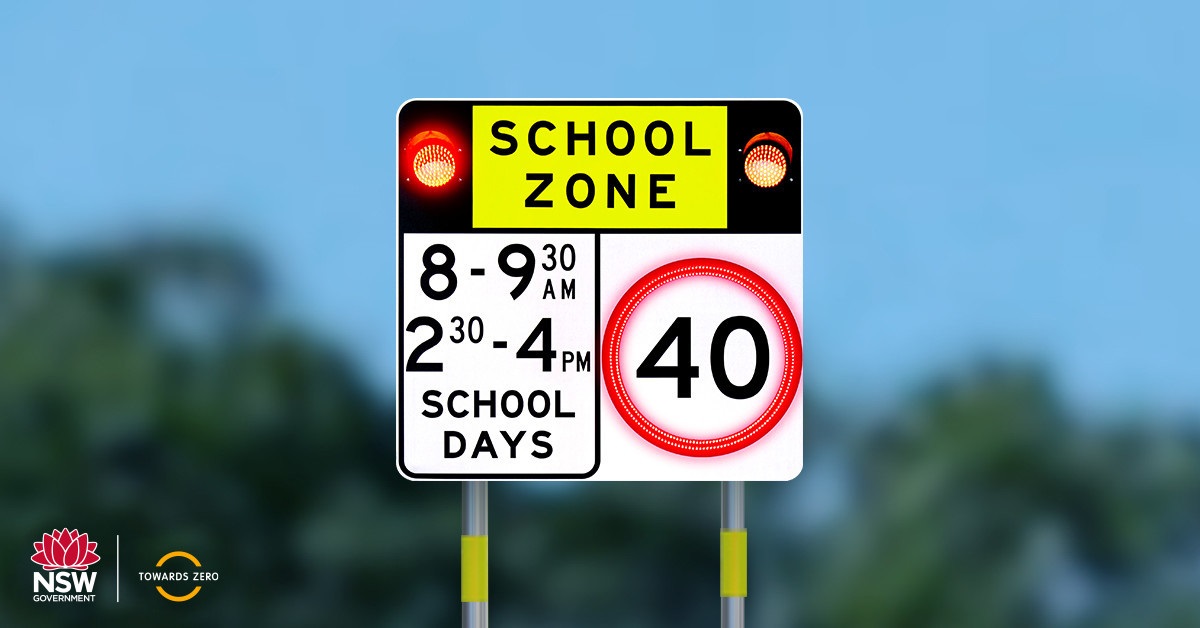
Most school zones operate from 8 to 9.30am and from 2.30 to 4pm. However, there are a small number of non-standard school zone times in NSW, which are identified by red/orange school zone signs showing the times when school zone flashing lights operate.
- Always park and turn legally around schools and avoid dangerous manoeuvres like U-turns and three-point turns.
- Its safest for children to get out of the car on the kerb side of the road to be away from passing traffic.
- Where provided, use Children’s Crossings to drop-off and pick-up children.
- Always hold your child’s hand.
- Always give way to pedestrians especially when entering and leaving driveways.
- Stick to the 40km/h speed limit in a school zone as children are about and can be unpredictable.
- Make sure that your children are in the correct car seat and that it is fitted and used correctly.
- Make sure that your child is wearing a helmet when riding a bike, scooter or skating.
- Look out for buses – 40km’h speed limit applies when school bus lights flash.
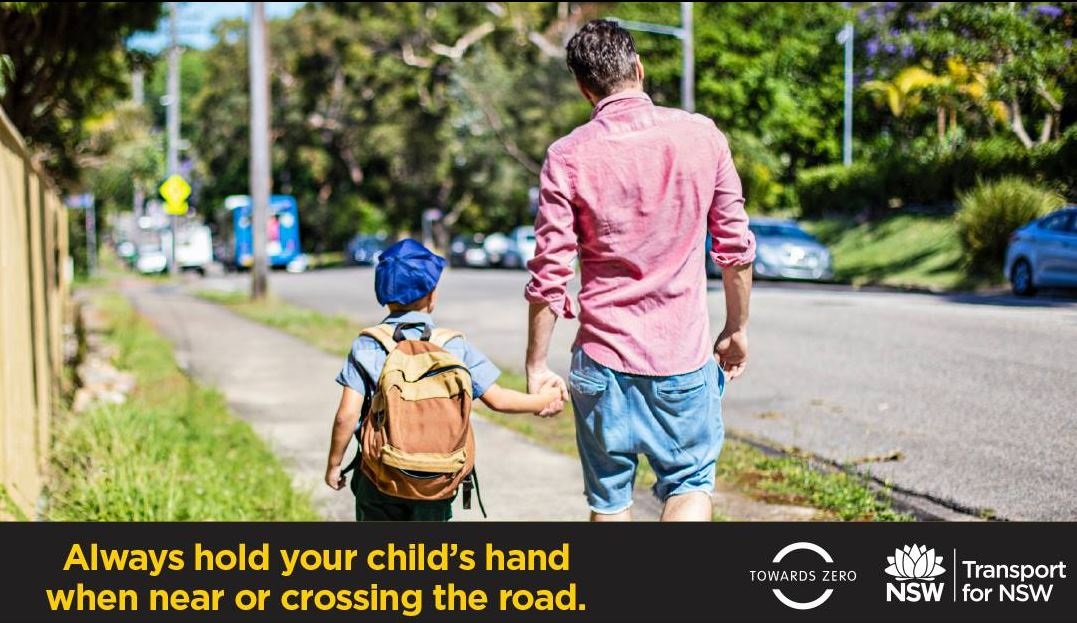
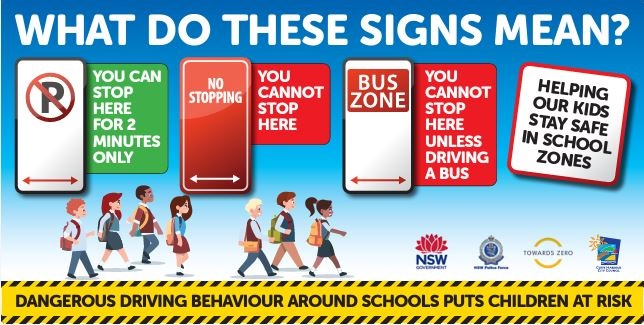
School zones
A school zone is the area around a school with a speed limit of 40 km/h. Between the 'SCHOOL ZONE' and 'END SCHOOL ZONE' signs you must obey the school zone speed limit. The school zone limit only applies on notified school days and during the times shown on the sign.
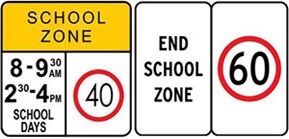
No parking
You must not stop for more than two minutes in a No Parking area. You must remain in or within 3 metres of the vehicle. Hours of operations may apply to some signs. This means restrictions apply for those times only. Mobility Parking Permit holders are allowed to park for up to 5 minutes in a No Parking area.

No stopping/no standing
These signs mean that in the area in the direction of the arrow you must not stop your vehicle at any point on the road or kerb, unless there is a medical or other emergency. Sometimes a no stopping area is indicated by a solid yellow edge line. Hours of operation may apply to some signs. This means restrictions apply for those times only.
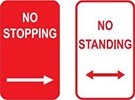
Bus zones
This sign means that in the direction of the arrow or arrows you are not allowed to stop your vehicle unless you are driving a bus. Hours of operation may apply to some signs. This means restrictions apply for those times only.

Loading zones
Only drivers of vehicles principally constructed for carrying goods may park their vehicle in a loading zone. These vehicles may stop for up to 30 minutes if they are being loaded or unloaded. A station wagon or a three-wheeled goods vehicle may stop for up to 15 minutes. If you are driving any other sort of vehicle you may only stop to pick up or set down passengers at the kerb. Hours of operation may apply to some signs. This means restrictions apply for those times only.

This animation highlights the difference between children’s crossings and pedestrian crossings, and what motorists need to do on approach to each type of crossing.
You and your child should always use a pedestrian crossing if there is one available. It is the safest point at which to cross a road. Share how to use the different pedestrian crossings with your child when you are out walking together. Model the correct behaviours - they learn from you.
Children's Crossings
Children's crossings are usually part-time crossings that operate before and after school hours. They can also operate at other times when children use the crossing for excursions or during break times. When the red 'Children Crossing' flags are displayed, you must stop at the white line if pedestrians are waiting to cross. Drivers must remain stopped until the crossing is clear of pedestrians.
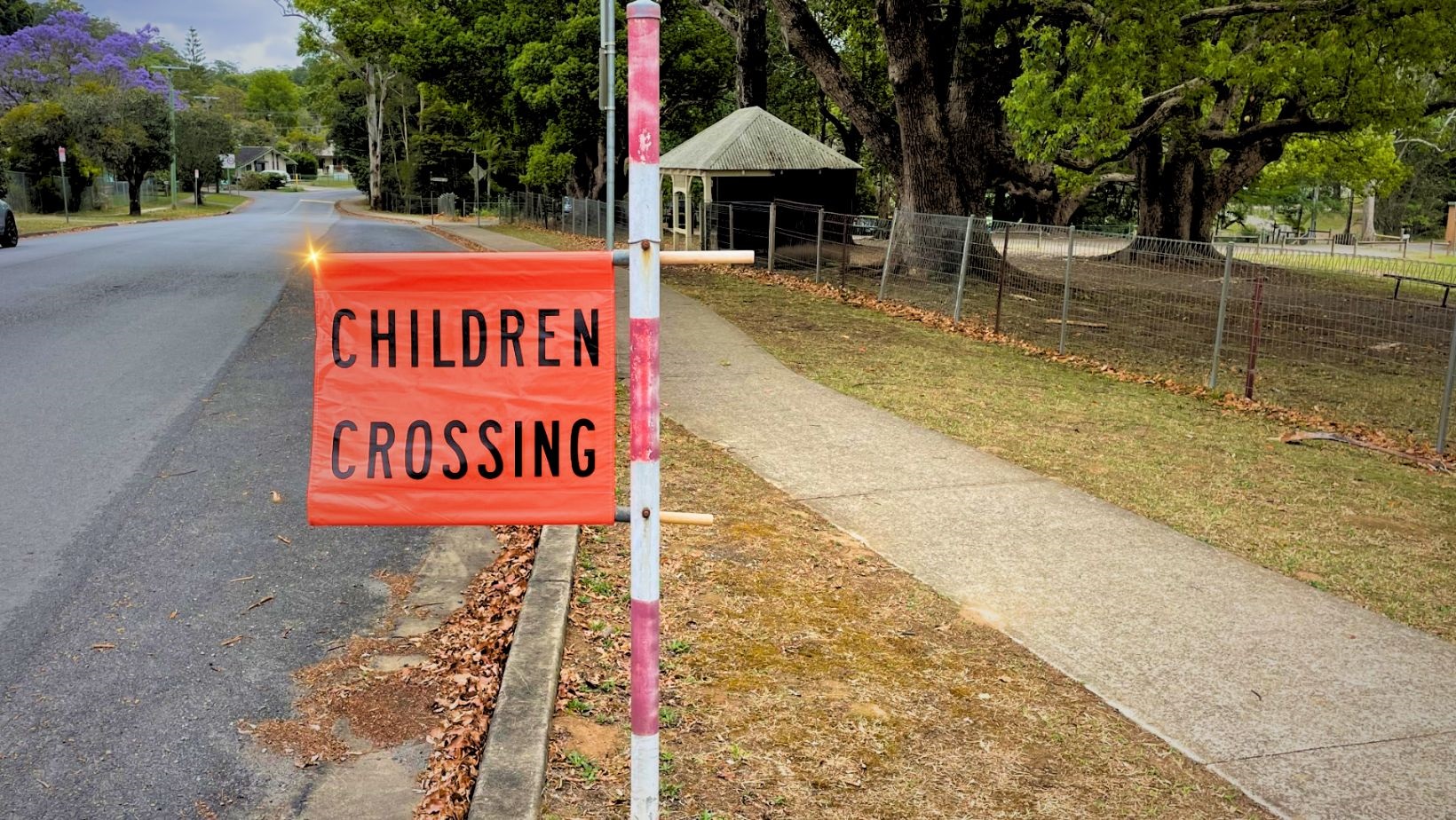
Pedestrian Crossings (zebra crossings)
Talk with your child about waiting until all vehicles have stopped before starting to cross. Some drivers may not stop for pedestrians. If you are driving, you must slow down and stop when a pedestrian steps onto a marked crossing. You must give way to any pedestrian on the crossing. Crossings with poor visibility have zigzag white lines painted on the road to warn drivers.
If there is school crossing supervisor, hold hands with your child and wait together on the footpath, at least one step back from the edge of the road, until the supervisor indicates that it is safe to enter the crossing.
If you are driving, you must stop until the crossing supervisor’s hand-held sign is no longer displayed, or until the supervisor indicates that you may proceed through the crossing.
|
Autumn holidays
|
Eastern and Western divisions
Monday 10 April to Friday 21 April 2023
|
|
Winter holidays
|
Eastern and Western divisions
Monday 03 July to Friday 14 July 2023
|
|
Spring holidays
|
Eastern and Western divisions
Monday 25 September to Friday 6 October 2023
|
|
Summer holidays
|
Eastern division
Wednesday 20 December 2023 to Monday 29 January 2024
|
|
Autumn holidays
|
Eastern and Western divisions
Monday 15 April to Friday 26 April 2024
|
|
Winter holidays
|
Eastern and Western divisions
Monday 08 July to Friday 19 July 2024
|
|
Spring holidays
|
Eastern and Western divisions
Monday 30 September to Friday 11 October 2024
|
|
Summer holidays
|
Eastern division
Wednesday 23 December 2023 to Monday 30 January 2025
|